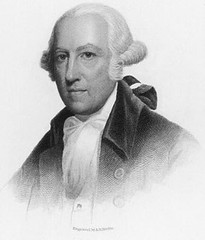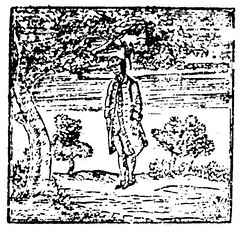
PREV ARTICLE
NEXT ARTICLE
FULL ISSUE
PREV FULL ISSUE
JAMES RIVINGTON (1724-1802)
John Lupia submitted the following information for this week's installment of his series on numismatic biographies. Thanks!
He's been working for years researching 18th century American numismatists and dealers, and has uncovered quite a bit of information that pushes back our knowledge of this area by over a century. His book will be titled Numismatic Collecting in 18th Century America. This week's subject is James Rivington - colonial printer, bookseller, patriot, spy, and coin dealer. -Editor
In order to steal away other English bookseller’s customers he advertised in America to sell at a 16 percent discount and a year’s credit. His large volume shop acted as a clearinghouse moving more stock than all of his competitors combined. After going bankrupt from gambling losses at the Newmarket races in 1758, he immigrated to New York in 1759, and opened a bookshop at Hanover Square with Samuel Brown, corner of Market and Front Streets, trading as Rivington & Brown. This is the same place that two years previous the earliest documented American coin auction had taken place by William Proctor (q.v.). The following year, 1760, he moved to Philadelphia to set up shop leaving the New York shop in the hands of his partner Brown. He returned to New York in 1762 and sold many articles besides books including art, curiosities and medals of King George and Queen Charlotte as advertised in the Pennsylvania Gazette, Thursday, April 22, 1762, page 4. Consequently, Rivington together with Peter McTaggart (q.v.), John Green and Joseph Russell trading as Green & Russell (q.v.), and Edmond Milne (q.v.) are among the earliest known coin dealers in America. Nevertheless, he opened a third bookstore at Boston with a new partner. After twelve years at New York he entered the newspaper industry and began to publish on April 22, 1773, The New York Gazetteer or the Connecticut, New Jersey, Hudson's River, and Quebec Weekly Advertiser (1773-1775). Though he averred to be a free “open and uninfluenced press” by November 1774 he was labeled as being a Loyalist. At that time he boasted of a circulation of 3,600 throughout the colonies. No patriot knew that in 1775 he was one of the very first agents in the secret service to the newly appointed General George Washington. Rivington suffered severe public, social and financial losses to keep up the appearance of being a Loyalist in order to be a convincing spy for the Revolutionary War's Continental Army.
“In consequence of his repeated attacks upon the Sons of Liberty, and especially Captain Isaac Sears, that officer came to New York from Connecticut with seventy-five horsemen, and, entering Rivington's office, destroyed his press and converted the types into bullets. Rivington's conduct was examined by the Provincial Congress, which referred the case to the Continental Congress, and while the latter was considering it the publisher wrote a remonstrance declaring, "that however wrong and mistaken he may have been in his opinions, he has always meant honestly and openly to do his duty as a servant of the public." He then made his peace with the Whigs, and was permitted to return to his house, but having incurred suspicion he afterward went to England, where he was appointed king's printer for New York. In 1777, after the British occupation of that city, he returned with a new press, and resumed the publication of his paper under the title of Rivington's New York Loyal Gazette, which he changed on 13 December, 1777, to The Royal Gazette. On the day when Major John André was taken prisoner his "Cow Chase" was published by Rivington. About 1781, when the success of the British was becoming doubtful, Rivington played the part of a spy, furnishing Washington with important information. His communications were written on thin paper, bound in the covers of books, and conveyed to the American camp by agents that were ignorant of their service. When New York was evacuated, Rivington remained in the city, much to the general surprise, removed the royal arms from his paper, and changed its title to Rivington's New York Gazette and Universal Advertiser. But his business rapidly declined, his paper ceased to exist in 1783, and he passed the remainder of his life in comparative poverty.”
His advertisement published in the late fall of 1782 reads : “To the Curious, For Sale, A Number of Foreign Coins, Gold, Silver, and Copper, many of them Ancient. – Enquire of the Printer.” Royal Gazette, Saturday, November 2, 1782, page 3, column 3. It was during the end of The Royal Gazette newspaper (1777-1783) that he published his own advertisement for the sale of these coins. The anti-royalists called his paper the “Lying Gazette.” Rivington’s newspaper had suffered from his believed to be political affiliations and so he turned to coin dealing by the late fall of 1782. He ceased publishing about a year later on December 31, 1783. His first marriage in 1752 to Elizabeth Mynshull (1752-1769), bore him three sons : James Rivington, Jr. (1769-1809), Henry Rivington (1770-?), and John Rivington (1772-1795), who became Maj. John Rivington. A decade after the death of his first wife he remarried on March 9, 1779, to Elizabeth Van Horne (Van Hooren) (d.1795), who bore him two sons and two daughters. This is attested to by the 1790 U. S. Census, which reported that he lived in the East Ward, New York City, New York, and had three sons at least sixteen years of age and two under, a wife and two daughters and eight slaves. He, like Thomas Jefferson died on the 4th of July, except in the year 1802 at New York City, New York. To read the complete article, see:
To read the earlier E-Sylum articles, see:
Wayne Homren, Editor The Numismatic Bibliomania Society is a non-profit organization promoting numismatic literature. See our web site at coinbooks.org. To submit items for publication in The E-Sylum, write to the Editor at this address: whomren@gmail.com To subscribe go to: https://my.binhost.com/lists/listinfo/esylum All Rights Reserved. NBS Home Page Contact the NBS webmaster 
|


